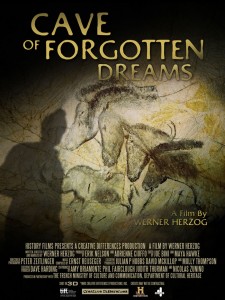Werner Herzog’s latest journey into the depths of philosophical quandaries about art and science is also a sincere voyage from the heart of one of cinema’s wisest souls. Cave of Forgotten Dreams is a 3D documentary that takes you into the Chauvet Pont D’Arc Cave in France, a remarkable historical treasure trove discovered only 17 years ago. In 1994, scientists unearthed the entrance to the crystal-encrusted cavern containing incredible drawings dating back nearly 30,000 years, from the age of Neanderthal caveman. Few people have had the kind of access that Herzog was able to get in making this film, which explores both the unique cave drawings in stunning detail while also profiling the unusual people drawn to this magical place.
By incorporating the use of 3D technology in a naturalistic style, Herzog has crafted perhaps the most intimate 3D movie to date. It is truly a one of a kind experience to descend alongside the legendary filmmaker, as he narrates and ponders the philosophical implications of art from such a long time ago. What fascinates the now 70-year-old director is the idea of the birth of the artistic soul and how it might have happened in the instance in which the cavemen painted. It’s reminiscent of his brilliant 2008 documentary Encounters at the End of the World, in which the director traveled to Antarctica to meet the people who live and work there. In that film, he dissected the landscape and contrasted it with the locals to create a moving portrait of the human psyche. With Cave of Forgotten Dreams, he explores a similar examination of how these drawings from another time are important for us to treasure now.

Herzog is no stranger to hypnotic documentaries about odd subjects and has steadily been making them throughout his career, closing in on his impressive number of narrative films. Oftentimes these blur the lines of reality and feel as if they were shot in some sort of augmented documentary style. Whatever film he decides to make, he continues to focus on themes close to his heart, like the struggle of man versus nature. These themes are further investigated in Forgotten Dreams as Herzog pontificates on horses animated in the firelight of the caves, thousands of years ago and musical flutes made of bird’s bones. There’s no shortage of fascinating and bizarre stories that are born from the age old art, the scientists studying it from every angle and the naturalists drawn to the area to be in touch with the artifacts of human’s origins.
Some may be quick to shrug off Herzog’s heavy narration as unnecessary, but for fans of the German pioneer, they will recognize it as thoughtful insight into the questions that motivate him to continue to make films. Its questions that force you to contemplate the meaning of our existence in a manner that is inviting, while also teaching us something about this world we had no idea existed. Herzog is a modern day philosopher in the vein of Sartre or Camus who speaks directly to his audience through the unique medium of filmmaking. Most people with an open mind will feel privileged to have the wise Herzog continue to guide us in his journey to further understand not just the nature of art, but the nature of humanity.



